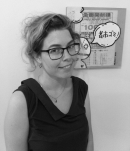Contact
Department of Sociology and Anthropology
Faculty of Social Sciences
Ramat-Aviv, 69978
Israel
Email:
Mayatrip2004@yahoo.com
Further Information
Dissertation Project
Online inspiration: The place of digital technology and the Internet in the creation process of graphic designers in Israel
In recent years in Israel, design has proliferated across academia, media and public discourse. Master programs in Design Studies have emerged and conference debates on design and psychology, design and business and design and anthropology have taken place. Furthermore, our lives are circling around apps, web sites, digital wearables and so on, making images and the visual a more dominant part of our everyday interactions. Thus, it is most interesting to investigate questions regarding the visual experts of our time- graphic designers. Graphic designers' process of creation is entangled in digital technology such as tablets, mice, digital pens, special computer screens and so on in combination with the more social side of the internet: designated social network sites such as Dribbble and Behance. These sites are directed to visual designers and offer a social learning experience with other, more or less experienced colleges.
One of the more dominant professional tools for designer is called "inspiration". Inspiration is reached by learning other designers' work, general design trend with the aid of visual "mood boards". The combination of these three elements helps achieve a new idea for a design (Eckert and Stacey, 2000). The questions that arise are what happens to "inspiration" (or, social learning) when the process moves to the internet? Is the process still a group process or an individual one? How does it go about? Where do designers go to find their visual inspiration online? Did their creation process change when they moved to an online space?
Few researches have examined the move of creative professionals to using a computer and the internet in their work. Henderson (1999) documented draftsmen in the engineering field before and after the move to the CAD software accrued. The computation of their work, which classically involved sketches by hand, changed their team dynamics, their working hours and their professional status in their organization. The question arises if the same will occur with younger graphic designers in the constantly-progressing field of design?
Methodologically, I ask to perform 30+ interviews with Israeli graphic designer who finished 4 years of higher studies in the field of design. I intend to join them on their working day and ask them questions about their use of digital tools and the internet. Performing an ethnography regarding users' use of the internet is best performed when the researcher directly asks their informants about their internet use and not just "lurks" online (Constable, 2003).
The research is set to contribute to the fields of anthropology of creation in the internet age, of design studies and of creative professionals' working processes in Israel and in general.
Supervisor: Prof. Ofra Goldstein-Gidoni


